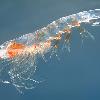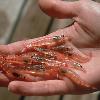

Reverted to version as of 2333, 14 July 2005 Tags: Krill View |
Tags: Krill View |
Tags: Krill View |
|||||||||
Euphausiacea ordo_authority=Dana (James Dwight Dana), 1852 subdivision_ranks=Families (Family (biology)) and genera (genus) subdivision = Euphausiidae *Euphausia Dana, 1852 *Meganyctiphanes Holt (Ernest William Lyons Holt) and W. M. Tattersall (Walter Medley Tattersall), 1905 *Nematobrachion Calman (William Thomas Calman), 1905 *Nematoscelis G. O. Sars (Georg Sars), 1883 *Nyctiphanes G. O. Sars, 1883 *Pseudeuphausia Hansen (Hans Jacob Hansen), 1910 *Stylocheiron G. O. Sars, 1883 *Tessarabrachion Hansen, 1911 *Thysanoessa Brandt (Johann Friedrich von Brandt), 1851 *Thysanopoda Latreille (Pierre Andr� Latreille), 1831 Bentheuphausiidae *Bentheuphausia amblyops G. O. Sars, 1883
Krill is a shrimp-like marine invertebrate animal. These small crustaceans are important organisms of the zooplankton, particularly as food for baleen whales, manta rays, whale sharks, crabeater seals, other seals (pinniped), and a few seabird species that feed almost exclusively on them. Another name is euphausiids, after their taxonomic order (order (biology)) Euphausiacea. The name krill comes from the Norwegian (Norwegian language) word langnokrill meaning "young fry (Spawn (biology)#Fry) of fish," which is also often attributed to other species of fish.
Krill occur in all oceans of the world. They are considered an important trophic connection - near the bottom of the food chain - because they feed on phytoplankton and to a lesser extent zooplankton, converting these into a form suitable for many larger animals for whom krill makes up the largest part of their diet. In the Southern Ocean, one species, the Antarctic krill, Euphausia superba, makes up an estimated biomass (biomass (ecology)) of over 500 million tonnes, roughly twice that of humans. Of this, over half is eaten by whales, seals (pinniped), penguins, squid and fish each year, and is replaced by growth and reproduction. Most krill species display large daily vertical migrations, thus providing food for predators near the surface at night and in deeper waters during the day.
Commercial fishing of krill is done in the Southern Ocean and in the waters around Japan. The total global harvest amounts to 150,000-200,000 tonnes annually, most of this from the Scotia Sea. Most of the krill catch is used for aquaculture and aquarium feeds, as bait (bait (luring substance)) in sport fishing, or in the pharmaceutical industry. In Japan and Russia, krill is also used for human consumption and is known as nihongookiami????ref1 in Japan.
Regnum: Animalia
Phylum: Arthropoda
Subphylum: Crustacea (Crustacean)
Classis: Malacostraca
Superordo: Eucarida



